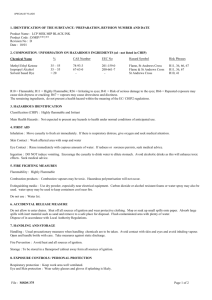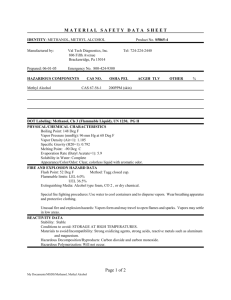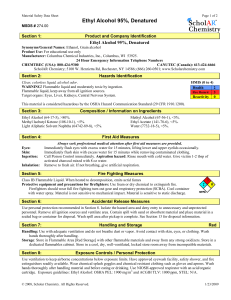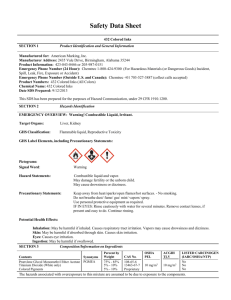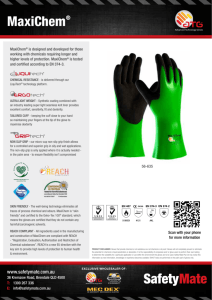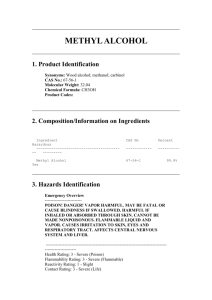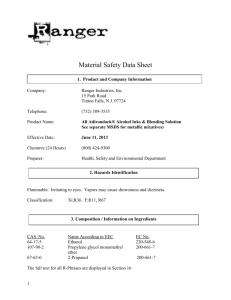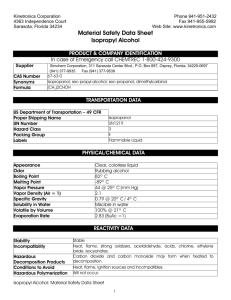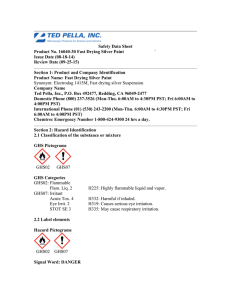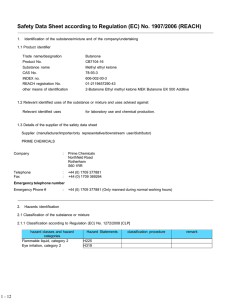Methyl Ethyl Ketone (MEK) MSDS | Safety Data Sheet
advertisement
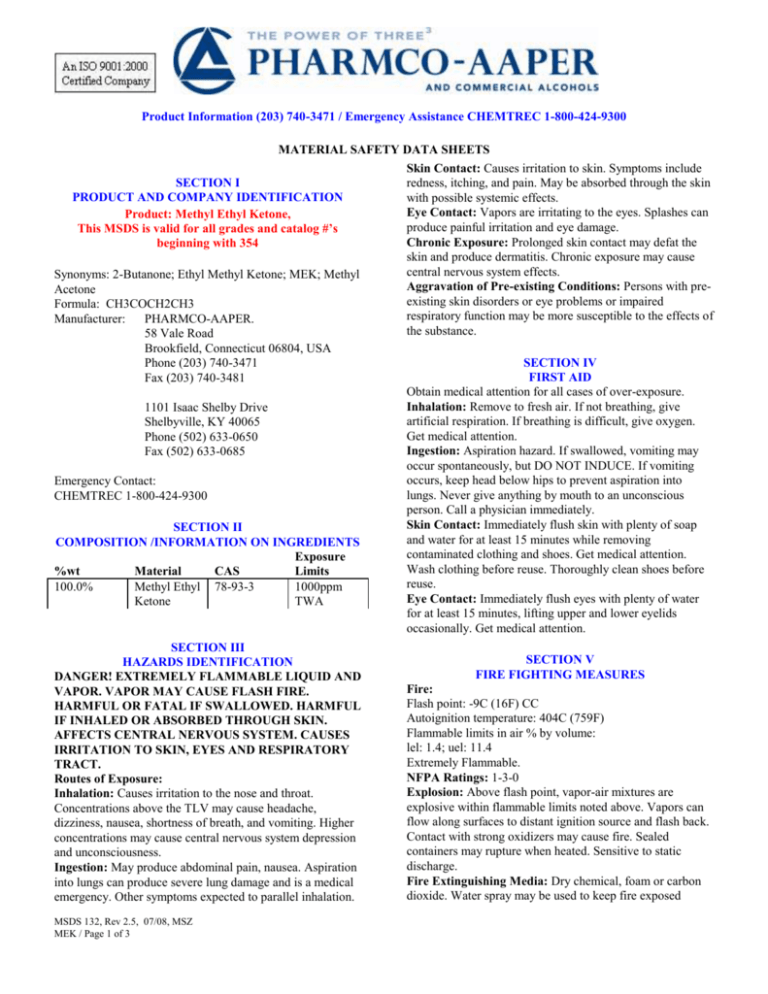
Product Information (203) 740-3471 / Emergency Assistance CHEMTREC 1-800-424-9300 MATERIAL SAFETY DATA SHEETS Skin Contact: Causes irritation to skin. Symptoms include SECTION I redness, itching, and pain. May be absorbed through the skin PRODUCT AND COMPANY IDENTIFICATION with possible systemic effects. Eye Contact: Vapors are irritating to the eyes. Splashes can Product: Methyl Ethyl Ketone, produce painful irritation and eye damage. This MSDS is valid for all grades and catalog #’s Chronic Exposure: Prolonged skin contact may defat the beginning with 354 skin and produce dermatitis. Chronic exposure may cause central nervous system effects. Synonyms: 2-Butanone; Ethyl Methyl Ketone; MEK; Methyl Aggravation of Pre-existing Conditions: Persons with preAcetone existing skin disorders or eye problems or impaired Formula: CH3COCH2CH3 respiratory function may be more susceptible to the effects of Manufacturer: PHARMCO-AAPER. the substance. 58 Vale Road Brookfield, Connecticut 06804, USA SECTION IV Phone (203) 740-3471 FIRST AID Fax (203) 740-3481 Obtain medical attention for all cases of over-exposure. Inhalation: Remove to fresh air. If not breathing, give 1101 Isaac Shelby Drive artificial respiration. If breathing is difficult, give oxygen. Shelbyville, KY 40065 Get medical attention. Phone (502) 633-0650 Ingestion: Aspiration hazard. If swallowed, vomiting may Fax (502) 633-0685 occur spontaneously, but DO NOT INDUCE. If vomiting occurs, keep head below hips to prevent aspiration into Emergency Contact: lungs. Never give anything by mouth to an unconscious CHEMTREC 1-800-424-9300 person. Call a physician immediately. Skin Contact: Immediately flush skin with plenty of soap SECTION II and water for at least 15 minutes while removing COMPOSITION /INFORMATION ON INGREDIENTS contaminated clothing and shoes. Get medical attention. Exposure Wash clothing before reuse. Thoroughly clean shoes before %wt Material CAS Limits reuse. 100.0% Methyl Ethyl 78-93-3 1000ppm Eye Contact: Immediately flush eyes with plenty of water Ketone TWA for at least 15 minutes, lifting upper and lower eyelids occasionally. Get medical attention. SECTION III HAZARDS IDENTIFICATION DANGER! EXTREMELY FLAMMABLE LIQUID AND VAPOR. VAPOR MAY CAUSE FLASH FIRE. HARMFUL OR FATAL IF SWALLOWED. HARMFUL IF INHALED OR ABSORBED THROUGH SKIN. AFFECTS CENTRAL NERVOUS SYSTEM. CAUSES IRRITATION TO SKIN, EYES AND RESPIRATORY TRACT. Routes of Exposure: Inhalation: Causes irritation to the nose and throat. Concentrations above the TLV may cause headache, dizziness, nausea, shortness of breath, and vomiting. Higher concentrations may cause central nervous system depression and unconsciousness. Ingestion: May produce abdominal pain, nausea. Aspiration into lungs can produce severe lung damage and is a medical emergency. Other symptoms expected to parallel inhalation. MSDS 132, Rev 2.5, 07/08, MSZ MEK / Page 1 of 3 SECTION V FIRE FIGHTING MEASURES Fire: Flash point: -9C (16F) CC Autoignition temperature: 404C (759F) Flammable limits in air % by volume: lel: 1.4; uel: 11.4 Extremely Flammable. NFPA Ratings: 1-3-0 Explosion: Above flash point, vapor-air mixtures are explosive within flammable limits noted above. Vapors can flow along surfaces to distant ignition source and flash back. Contact with strong oxidizers may cause fire. Sealed containers may rupture when heated. Sensitive to static discharge. Fire Extinguishing Media: Dry chemical, foam or carbon dioxide. Water spray may be used to keep fire exposed containers cool, dilute spills to nonflammable mixtures, protect personnel attempting to stop leak and disperse vapors. Special Information: In the event of a fire, wear full protective clothing and NIOSH-approved self-contained breathing apparatus with full facepiece operated in the pressure demand or other positive pressure mode. This highly flammable liquid must be kept from sparks, open flame, hot surfaces, and all sources of heat and ignition. SECTION VI SPILL/ACCIDENTAL RELEASE MEASURES Ventilate area of leak or spill. Remove all sources of ignition. Wear appropriate personal protective equipment as specified in Section 8. Isolate hazard area. Keep unnecessary and unprotected personnel from entering. Contain and recover liquid when possible. Use non-sparking tools and equipment. Collect liquid in an appropriate container or absorb with an inert material (e. g., vermiculite, dry sand, earth), and place in a chemical waste container. Do not use combustible materials, such as saw dust. Do not flush to sewer! If a leak or spill has not ignited, use water spray to disperse the vapors, to protect personnel attempting to stop leak, and to flush spills away from exposures. US Regulations (CERCLA) require reporting spills and releases to soil, water and air in excess of reportable quantities. SECTION VII HANDLING AND STORAGE Flammable material - keep away from heat, sparks, and flame; sudden releases of hot organic vapors or mists from process equipment operating at elevated temperature may result in ignitions without the presence of obvious ignition sources. Avoid contact with eyes. Keep container closed. Use with adequate ventilation. Ground container when transferring product. Vapors may collect in containers; treat empty containers as hazardous. Wash thoroughly after handling Vapors may settle in low or confined areas SECTION VIII EXPOSURE CONTROLS / PERSONAL PROTECTION Airborne Exposure Limits: -OSHA Permissible Exposure Limit (PEL): 200 ppm (TWA) -ACGIH Threshold Limit Value (TLV): 200 ppm (TWA), 300 ppm (STEL) Ventilation System: A system of local and/or general exhaust is recommended to keep employee exposures below the Airborne Exposure Limits. Local exhaust ventilation is generally preferred because it can control the emissions of the contaminant at its source, preventing dispersion of it into the general work area. Use explosion-proof equipment. Personal Respirators (NIOSH Approved): If the exposure MSDS 132, Rev 2.5, 07/08, MSZ MEK / Page 2 of 3 limit is exceeded and engineering controls are not feasible, a full facepiece respirator with organic vapor cartridge may be worn up to 50 times the exposure limit or the maximum use concentration specified by the appropriate regulatory agency or respirator supplier, whichever is lowest. For emergencies or instances where the exposure levels are not known, use a full-facepiece positive-pressure, air-supplied respirator. Skin Protection: Wear impervious protective clothing, including boots, gloves, lab coat, apron or coveralls, as appropriate, to prevent skin contact. Butyl rubber is a suitable material for personal protective equipment. Eye Protection: Use chemical safety goggles and/or a full face shield where splashing is possible. Maintain eye wash fountain and quick-drench facilities in work area. SECTION IX PHYSICAL AND CHEMICAL PROPERTIES Appearance: Clear, colorless liquid. Odor: Sharp mint-like odor. Solubility: 29 g in 100 g of water. Specific Gravity: 0.81 @ 20C/4C pH: No information found. % Volatiles by volume @ 21C (70F): 100 Boiling Point: 80C (176F) Melting Point: -86C (-123F) Vapor Density (Air=1): 2.5 Vapor Pressure (mm Hg): 78 @ 20C (68F) Evaporation Rate (BuAc=1): 2.7 (Ether = 1) SECTION X STABILITY/REACTIVITY INFORMATION Stability: Stable under ordinary conditions of use and storage. Hazardous Decomposition Products: Carbon dioxide and carbon monoxide may form when heated to decomposition. Hazardous Polymerization: Will not occur. Incompatibilities: Oxidizing materials, caustics, amines, ammonia, strong bases, chloroform, chlorosulfonic acid, oleum, potassium-t-butoxide, heat or flame, hydrogen peroxide, nitric acid. Can attack many plastics, resins and rubber. Conditions to Avoid: Heat, flames, ignition sources and incompatibles. SECTION XI DISPOSAL CONSIDERATIONS Vapors may collect in empty containers. Treat empty containers as hazardous. Dispose of spill-clean up and other wastes in accordance with Federal, State, and local regulations. SECTION XII TRANSPORTATION INFORMATION Domestic (Land, D.O.T.) Proper Shipping Name: ETHYL METHYL KETONE Hazard Class: 3 UN/NA: UN1193 Packing Group: II Information reported for product/size: 366LB International (Water, I.M.O.) Proper Shipping Name: ETHYL METHYL KETONE Hazard Class: 3 UN/NA: UN1193 Packing Group: II Information reported for product/size: 366LB SECTION XIII REGULATORY INFORMATION Federal EPA Comprehensive Environmental Response Compensation, and Liability Act of 1980 (CERCLA): No chemicals in this material with known CAS numbers are subject to the reporting requirements of CERCLA Superfund Amendments and Reauthorization Act of 1986 (SARA) Title III requires emergency planning based on threshold planning quantities and release reporting based on reportable quantities in 40 CFR 355 (used for SARA 302, 304, 311, and 312). Based upon available information, this material is classified as the following health and/or physical hazard according to section 311 & 312: Immediate (Acute) Health Hazard, Delayed (Chronic) Health Hazard, Fire Hazard. Superfund Amendments and Reauthorization Act of 1986 (SARA) Title III requires submission of annual reports of release of toxic chemicals that appear in 40 CFR 372 (for SARA 313): This material does not contains any chemical components with known CAS numbers that exceed the reporting limits. Toxic Substances Control Act (TSCA) Status: All components of this product are exempt from listing on the TSCA inventory. Comprehensive Environmental Response, Compensation, and Liability Act of 1980 (CERCLA) requires notification of the National Response Center of release of quantities of Hazardous Substances equal or greater than the reportable quantities (RQs) in 40 CFR 302.4. Components present in this product at a level which could require reporting under the statute are: Chemical Name CAS Number RQ Methyl ethyl ketone 78-93-3 5,000lb State Right to Know No components of this product are listed on the California Prop 65 lists. The information contained herein is based on data considered to be accurate. However, no warranty is expressed regarding the accuracy of these data or the results to be obtained from the use thereof. It is the user’s obligation to determine the conditions of safe use of the product. MSDS 132, Rev 2.5, 07/08, MSZ MEK / Page 3 of 3
